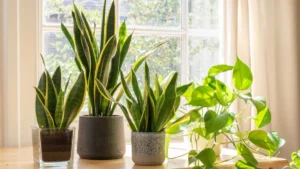Snake plants, also called Sansevieria or mother-in-law’s tongue, are popular for their upright, sword-like leaves and easy care. However, sometimes their leaves start to droop, bend, or lean to the side. If this happens to your plant, don’t worry — it’s fixable!
In this guide, we’ll explore why your snake plant’s leaves may be bending and how you can help them grow tall and healthy again.
Why Do Snake Plant Leaves Bend or Fall Over?
Before fixing the problem, it’s important to understand what’s causing it. There are several common reasons why snake plant leaves might start to lean or droop:
- Not Enough Light
Snake plants can survive in low light, but they don’t do their best there. If they don’t get enough light, the leaves weaken and start to fall over. - Too Much Water
Overwatering is a major cause of problems. When the soil stays wet for too long, the roots can rot, making the plant too weak to hold up its leaves. - Poor Soil and Drainage
Soil that doesn’t drain well can trap too much water, causing root rot. Without healthy roots, the plant struggles to stay upright. - Overgrown or Top-Heavy Leaves
As snake plants grow, their leaves can get heavy. If most of the new growth happens on one side, it can cause the plant to lean. - Wrong Pot Size
A pot that’s too large holds too much water, while a pot that’s too small doesn’t give the roots enough space to grow properly.
How to Encourage Snake Plants to Grow Upright
If your snake plant is leaning or drooping, follow these steps to help it stand tall again:
- Give It the Right Light
Place your snake plant in a spot with bright, indirect light, like near a window with sheer curtains. If the light is dim, consider using a grow light.
Tip: Rotate the plant every week so it doesn’t lean toward one direction. - Fix Your Watering Routine
Let the soil dry out completely between waterings. Stick your finger 2–3 inches into the soil. If it’s dry, it’s time to water. Don’t water on a fixed schedule.
Overwatering weakens the roots, which makes it hard for the plant to stand tall. - Use Well-Draining Soil
Snake plants need soil that drains well. You can use a cactus or succulent mix, or make your own by mixing:- 2 parts potting soil
- 1 part perlite or coarse sand
- 1 part coco coir or peat moss
This mix helps water drain quickly and keeps the roots healthy.
- Repot When Necessary
If your snake plant has outgrown its pot or the roots are crowded, repot it into a slightly larger container. Always choose pots with drainage holes. Terracotta pots work well because they absorb excess moisture. - Support the Leaves
If your leaves are leaning, use plant ties or soft string to gently secure them to a bamboo or wooden stick in the soil. Make sure the ties aren’t too tight. - Trim Damaged Leaves
If any leaves are badly bent or soft, prune them at the base with clean scissors or a knife. Trimming damaged leaves helps the plant focus on growing new, strong ones. You can also propagate the healthy parts in water or soil. - Maintain a Stable Environment
Snake plants prefer temperatures between 60°F and 85°F (15°C to 29°C). Avoid placing them near cold drafts or heating vents. While humidity isn’t a major issue, extreme dryness or wetness can harm growth.
Common Mistakes to Avoid
To keep your snake plant healthy, avoid these common mistakes:
- Overwatering or using pots without drainage
- Placing the plant in dark, isolated corners
- Letting the plant grow too tall without support
- Ignoring signs of root rot, like mushy leaves or a bad smell
Conclusion
Caring for a snake plant and keeping its leaves upright is easy once you know what it needs. Focus on providing the right light, watering correctly, using well-draining soil, and pruning when necessary. If your plant is already leaning, support it and adjust its environment.
With proper care, your snake plant will reward you with healthy, upright leaves and a striking look that adds beauty to any indoor space.
FAQs
How often should I water my snake plant?
Water your snake plant only when the top 2–3 inches of soil feel dry. It’s better to underwater than overwater.
Why is my snake plant’s soil always soggy?
The most likely cause is poor drainage. Make sure your pot has drainage holes, and use soil that allows water to drain quickly.
Can I fix a leaning snake plant without repotting it?
Yes! You can support the plant with stakes or ties to help it grow upright, and adjust its watering and light conditions to improve its health.
What should I do if my snake plant leaves are turning yellow?
Yellow leaves could be a sign of overwatering, poor drainage, or too much sunlight. Check your watering routine and make sure the plant isn’t getting too much direct sun.

